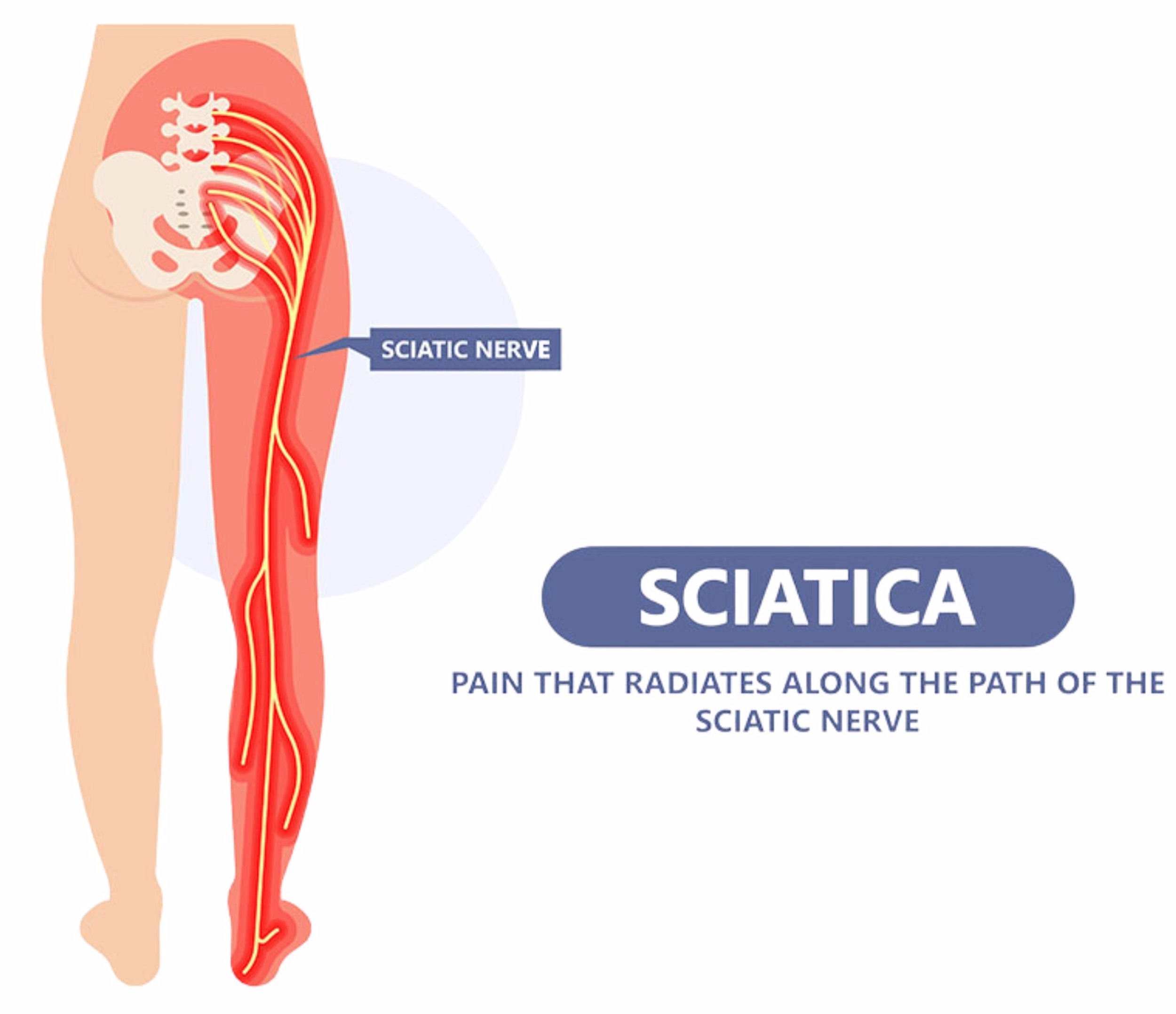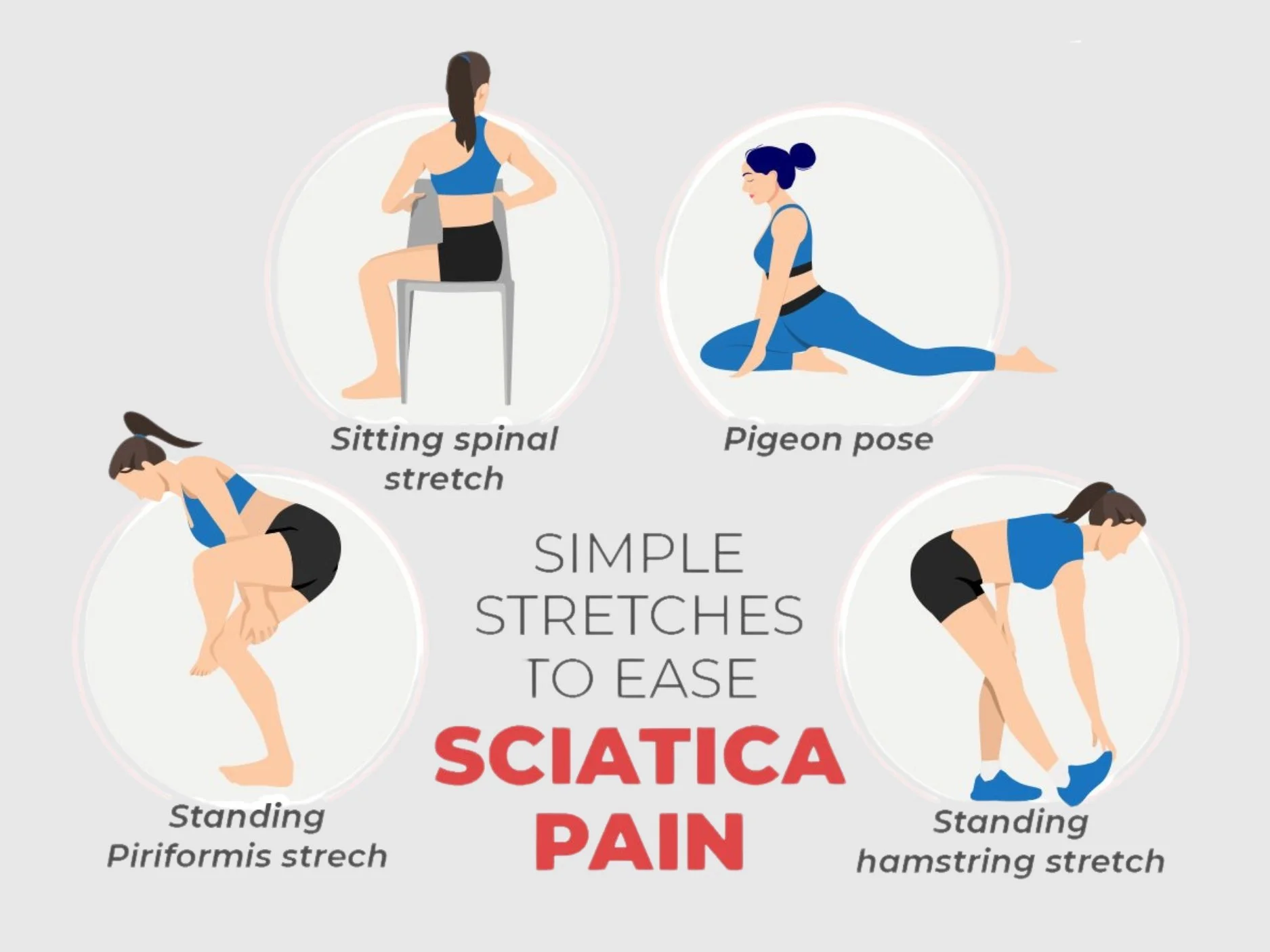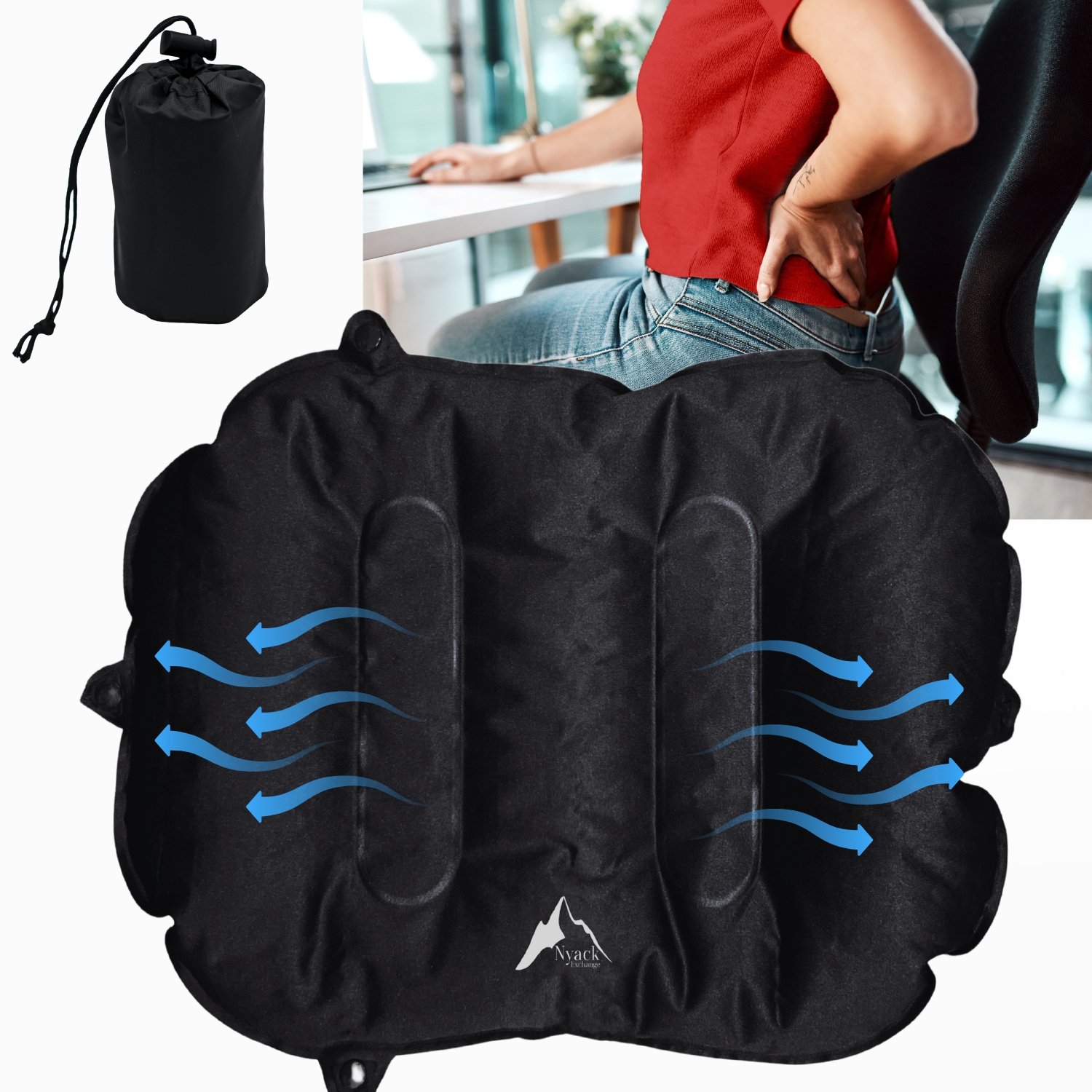Sciatica Relief: Effective Home Stretches you can do right now
Sciatica Relief: Effective Home Stretches you can do right now
Pain radiates down your leg, a sharp reminder of the discomfort that lingers. Sciatica is more than an inconvenience—it's a signal.
There's a path to relief. With a series of stretching exercises tailored to ease the sciatic nerve's distress, you can reclaim control over your mobility and reduce pain. At home, where comfort meets convenience, lies an opportunity to gently coax your body into a place of greater ease and freedom. Begin with intention and consistency, and observe how your journey toward alleviating sciatica pain takes shape.
Understanding Sciatica
Sciatica, a term that often conjures images of debilitating back pain, originates from irritation or compression of the sciatic nerve. This nerve, the longest in the human body, branches from your lower back through your hips and buttocks, descending along each leg. Recognizing sciatica's symptoms is critical; they include lower back pain, numbness in the legs, and a sharp, burning sensation that can incapacitate.
Addressing sciatica successfully hinges on understanding its root causes, which range from herniated discs to degenerative disc disease. Identifying the specifics of your condition paves the way for targeted home stretching exercises, instrumental in mitigating discomfort and restoring function.
Identifying Your Symptoms
Sciatica’s unique hallmark is a sharp, radiating pain, originating in the lower back and shooting down one leg. Recognize the tingling or numbness that often accompanies it as a sign to act.
Often described by sufferers as a jolt or electric shock, these symptoms should not be ignored. If experienced, they indicate the sciatic nerve is likely under duress, warranting immediate attention.
Sciatic pain often worsens with prolonged sitting or during sudden movements.
Effective management begins with acknowledgment: You understand something isn't right with your body. Pay attention to signals like pain during standing or a reduction in leg mobility. These markers are your body's plea for care and should be met with both urgency and compassion.
The Sciatic Nerve Explained
The sciatic nerve is the longest and widest nerve in the human body, fundamental to leg movement and sensation.
Origin: The sciatic nerve roots emerge from the lower spine.
Pathway: It runs through the buttocks, extending down the back of each leg.
Branches: At the knee, it branches into nerves that continue to the feet and toes.
Function: It controls the muscles in the back of the knee and lower leg.
Sensation: The nerve provides feeling to the thighs, legs, and feet.Impingement or irritation of this nerve can lead to sciatica.
Understanding its course and influence provides a base to appreciate why stretching is crucial for relief.
Pre-Stretching Essentials
Before embarking on your journey towards sciatica relief, it’s important to create an environment conducive to healing and movement. A quiet, comfortable space clears the mind and facilitates focus on the body’s signals, enhancing the effectiveness of each stretch. Temperature matters too; a warm room can help relax muscles more readily than a cold one, setting the stage for a more pliable and responsive body.
In addition to the physical space, your approach to stretching must embody patience and mindfulness. Approaching stretches with a "warm-up mindset" is key; gentle movements prepare the muscles and the nervous system for more intense activity. Remember, the goal here is not speed but rather consistent progress. A gradual increase in stretching intensity protects the delicate balance between effort and recovery, ensuring you weave the fabric of healing with a steady and careful hand.
Warm-Up Techniques
Activating your muscles with proper warm-up techniques is foundational to effective stretching and sciatica relief.
Begin with light aerobic activity such as walking or cycling for about 5 minutes to increase blood flow.
Progress to gentle dynamic stretches; leg swings and arm circles can help mobilize the joints.
Incorporate deep diaphragmatic breathing; synchronize your breath with movement to oxygenate the muscles.Short, engaging warm-ups set a positive tone for your stretching routine, priming your body for optimal performance.
A thoughtful warm-up can make the difference between a productive session and potential strain, ensuring each stretch brings you closer to comfort and mobility.
Safety Tips for Stretching
Before you start stretching, ensure you're in a safe environment conducive to healing and recovery.
Consult with a healthcare professional, especially if you're experiencing severe pain or have specific medical conditions.
Listen to your body and honor its signals, stopping immediately if you feel sharp or increasing pain.
Move into stretches slowly and gently, avoiding any jerky or bouncing movements that can cause injury.
Hold stretches for the recommended time, typically 20-30 seconds, to gain maximum benefit without overexertion.
Use proper form, as incorrect positioning can negate the benefits of the stretch and potentially cause harm.Recognize that some discomfort is normal, but pain is not.
Remember, patient progression is preferable to rushed results; your body's healing should not be hurried.
Targeted Sciatica Stretches
The Sciatic nerve runs deeply, making targeted stretches essential for alleviating its irritation. Begin with a focus on the lower back and gluteal muscles, key areas where the sciatic nerve can become pinched.
In the pursuit of relief, the Piriformis stretch beckons, a gentle movement that eases sciatic pain by creating space in the hip area. Coupled with Seated spinal twists, these stretches synergistically decompress the nerve, fostering an environment conducive to healing.
Knee-to-chest pulls and Hamstring lengthening – these simple yet profoundly beneficial motions aid in releasing tension along the sciatic pathway.
Reclining Pigeon Pose
Sciatica sufferers, take note: the Reclining Pigeon Pose is a therapeutic escape from the gripping discomfort of sciatic pain.
Granting respite from sciatic nerve flare-ups, this pose targets your piriformis muscle, nestled deep within the gluteal region. By carefully stretching this muscle, the adjacent sciatic nerve experiences relief, easing the lumbar pain that often immobilizes you. This particular stretch not only mitigates discomfort but also promotes enhanced flexibility and mobility in your lower body. As you gently coax the piriformis into relaxation, the relief can cascade down your leg, addressing the root cause of your sciatica.
Subtle yet powerful, the Reclining Pigeon Pose invites you to lie on your back, a position of rest that allows for controlled stretching. Crossing one leg over the opposite thigh creates the figure-four shape crucial to the stretch's effectiveness. Maintaining this position briefly can alleviate the muscle tightness that often exacerbates sciatic symptoms. Moreover, engaging in this stretching ritual consistently fosters an increase in your range of motion, enhancing day-to-day function and comfort.
Embrace this pose as a sanctuary for your sciatic nerve, allowing the healing energy of gentle stretching to permeate your body. This non-invasive, restorative technique offers a pathway to reclaim mobility and reduce pain. Regular integration of the Reclining Pigeon Pose into your home therapy routine can significantly attenuate the intensity of sciatic episodes. Embody resilience and grace as you empower yourself to manage your symptoms, championing relief and a return to the activities you love.
Sciatic Nerve Flossing
Invite mobility back into your life.
Sciatic nerve flossing, a novel and dynamic stretch, engages your nervous system in a symphony of relief. Similar to flossing teeth, this technique gently mobilizes the sciatic nerve, helping to release entrapments and alleviate tingling or numbness. Performed methodically, nerve flossing can potentially restore nerve glide and function, reducing the distressing symptoms associated with sciatica.
Free your nerve from its painful trap.
By alternating leg movements that elongate and relax the sciatic nerve, flossing promotes healing. It is a safe, controlled action that can lead to remarkable improvements in nerve function and leg comfort. This stretch demonstrates the adaptability of our body's nervous system and its ability to recover with the proper care.
A small commitment for a leap in recovery.
Incorporate this strategy into your daily routine and witness the transformation. Integrating sciatic nerve flossing into your therapy regimen can be a game changer in your pursuit of well-being. Its consistent application may significantly mitigate your discomfort and enhance your overall quality of life. Adopt this technique for a resilient and more flexible you, and stride into a future where sciatica no longer dictates your limits.
Knees to Chest Stretch
The Knees to Chest stretch offers profound relief for sciatic pain, inviting gentle decompression of the lumbar spine. This movement can be a soothing balm for inflamed sciatic nerves, relieving pressure effectively.
Lie on your back, feet flat on the floor.
Slowly, bring your knees towards your chest, maintaining control.
This stretch elongates the spine, releasing tension.
Hold your knees securely and breathe deeply, focusing on a gradual extension of the lower back. This deliberate action encourages the spinal discs to realign, promoting an environment for healing and reducing irritation.
Make this stretch a cornerstone of your daily routine. It's an accessible way to actively participate in your recovery, potentially easing the intensity of sciatica symptoms with each repetition. Commit to this stretch and you may notice an increment in mobility and a decrease in discomfort over time.
Remember, consistency is key in managing sciatica pain. Regularly performing the Knees to Chest stretch may lead to sustainable improvement in your quality of life. Embrace this practice and regain the freedom to move without the shadow of pain.
Maintaining Sciatic Health
Consistency is the beacon light in the management of sciatic health; regular stretching aligns with the body's inherent desire for equilibrium. Incorporate a monitor-and-modify approach to your stretching regimen, adjusting your efforts in response to your body's communication—a dialogue of sensation, speaking to you through the language of comfort and pain.
Consistency is Key
Remember, sporadic efforts yield fragmented results. Daily dedication to stretching is pivotal for enduring sciatic relief.
Since sciatica can be a recurrent condition, daily stretching is akin to the routine maintenance required to keep the machinery of your body in optimal condition. Without regular upkeep, the complex system of nerves and muscles may fall into disrepair, setting the stage for pain's unwelcome return.
Adopting a regular stretching routine is not merely a reactive measure but a proactive approach to fortifying your musculoskeletal health against future sciatic flare-ups. Consistency acts as both shield and sword, defending against pain and actively promoting flexibility and strength.
In addition to stretches for sciatica there are a few lifestyle aids you can incorporate into your daily life to help lesson your discomfort. Products like the Nyack Exchange Inflatable Lumbar Support Pillow and the McKenzie Lumbar Roll can offer relief. These supports help maintain the natural curve of your lower spine, reducing pressure on the sciatic nerve. The inflatable pillow allows for customized firmness, while the lumbar roll promotes proper posture whether sitting or driving. By gently supporting the spine's natural alignment, these tools can alleviate sciatica discomfort and encourage healing
When to Consult Professionals
Should your stretches bring more pain than relief, it's time to seek professional guidance. When pain persists despite your efforts, a specialist's insight becomes invaluable in charting a path forward.
However, recognizing when to transition from self-help to professional care is crucial for your well-being. If you experience severe or worsening discomfort, loss of sensation, or if the pain significantly impairs your ability to perform daily activities, it's imperative to consult with a healthcare provider. They can offer advanced diagnostic tools and treatments that may be beyond the reach of home stretching routines.
Particularly, if your symptoms are accompanied by other concerning signs such as unexplained weight loss, fever, or changes in bowel or bladder function, a prompt medical evaluation is essential. These could be indicators of more serious underlying conditions that require immediate intervention.
If your self-administered stretches have not provided the expected relief after several weeks, consider a professional assessment. Experts can tailor a treatment plan that addresses your unique needs, potentially including physical therapy, medication, or even advanced interventions. Trust in their expertise to enhance your healing process and restore your quality of life.
Nyack Exchange is your ultimate resource for physical therapy tips and tools for at-home rehab. We understand the importance of personalized care and convenience, which is why we provide a wide range of resources to support your recovery journey. Whether you're looking for effective home stretches, expert advice, or innovative tools, Nyack Exchange has you covered. Our platform is designed to empower individuals recovering from injuries, offering a wealth of knowledge and practical solutions to help you achieve your goals. Trust Nyack Exchange to be your partner in at-home rehab, and take the first step towards a pain-free and mobile future.




